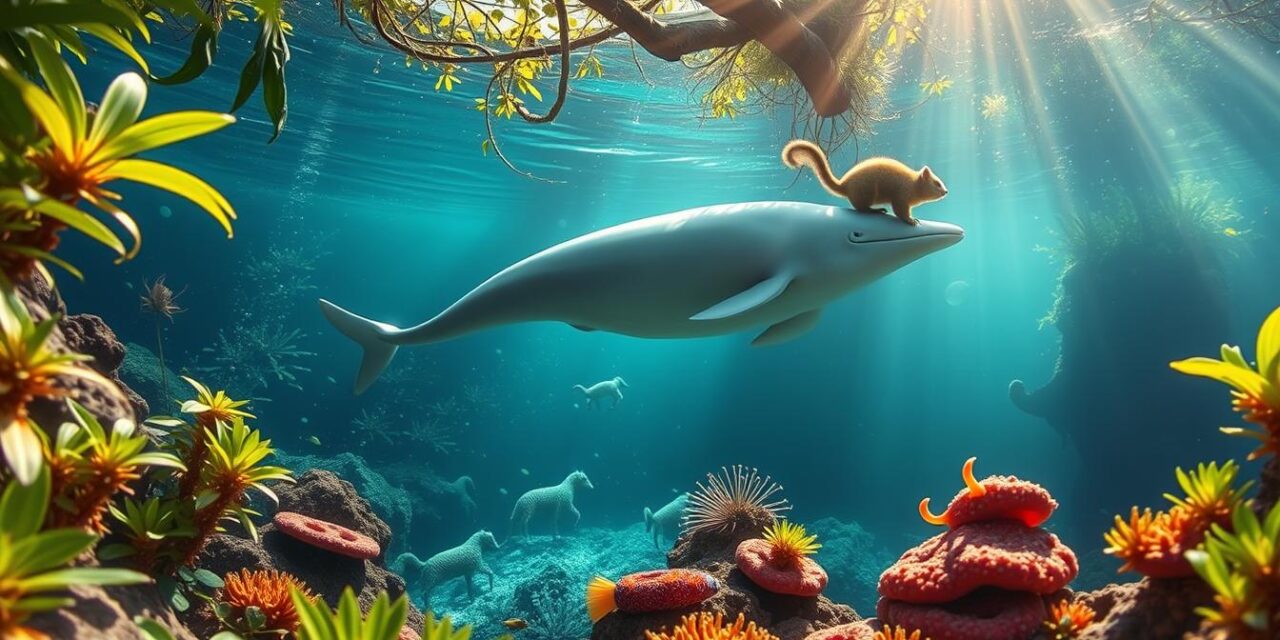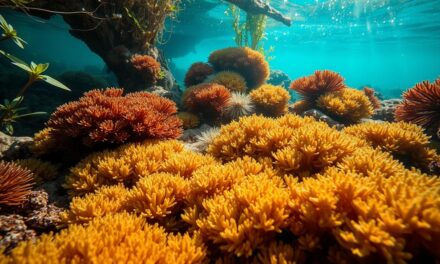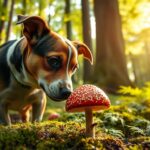From the captivating Narwhal to the graceful Nightingale, the animal kingdom is home to a vast array of fascinating creatures whose names begin with the letter ‘N’. But just how diverse are these “N” animals, and what unique characteristics set them apart? Join us as we explore the remarkable world of animals starting with the letter N.
Key Takeaways
- The animal kingdom is teeming with a diverse array of creatures whose names start with the letter ‘N’.
- These “N” animals exhibit a wide range of unique characteristics, from the Narwhal’s iconic spiral tusk to the Nightingale’s enchanting song.
- Exploring the diversity of animals beginning with the letter N can provide fascinating insights into the natural world.
- Understanding the habitats, behaviors, and adaptations of these creatures can help us appreciate the incredible biodiversity our planet has to offer.
- Discovering the wonders of “N” animals can inspire a deeper connection to the natural world and a greater appreciation for its marvels.
Introduction to Animals Starting with N
The animal kingdom is home to a diverse array of creatures, each with its own unique features and behaviors. Among this vibrant tapestry of life, there is a captivating group of animals that begin with the letter N. From the iconic Narwhal to the lesser-known Nuthatch, these animals showcase the incredible diversity of life on our planet.
Diverse Creatures with the Letter N
According to recent data, there are approximately 87 known animals that start with the letter N. These creatures span a wide range of classifications, including 29 mammals, 15 birds, 12 reptiles, 9 fish, 16 insects, and 6 others. Interestingly, around 8% of these “N” animals are now extinct, underscoring the importance of conservation efforts.
When it comes to popularity and online search trends, the top three “N” animals are the Narwhal, Numbat, and Nuthatch, while the least searched are the Nudibranch, Nene, and Nightcrawler. These diverse creatures also call a variety of habitats home, with 42% found in forests, 21% in deserts, 17% in oceans, 10% in grasslands, 7% in Arctic tundras, and 3% in wetlands.
From the majestic Nile crocodile to the unique Newt species found in the UK, the animals starting with N showcase the incredible diversity of our natural world. In the sections that follow, we’ll dive deeper into the fascinating lives and characteristics of some of these captivating creatures.
Narwhal: The Unicorn of the Sea
The narwhal, also known as the “unicorn of the sea,” is a captivating marine mammal found in the icy Arctic waters. With its distinctive long, spiral tusk that can reach up to 10 feet in length, the narwhal (Monodon monoceros) is a true wonder of nature.
These social creatures often travel in pods of around 15 individuals, though they can sometimes form larger aggregations of up to 1,000 during the summer months. Narwhals use their impressive tusks for a variety of purposes, including breaking through ice, defending against predators, and even communicating with other members of their pod.
Narwhals have adapted remarkably to the harsh Arctic environment, with a thick layer of blubber that can account for up to a third of their total body mass. This insulation helps them to thrive in the freezing waters, and their specialized skeletal muscles allow them to dive to depths of up to 1 mile in search of prey.
Despite their unique appearance and fascinating behaviors, narwhals are considered a species of least concern by the International Union for Conservation of Nature (IUCN), with a global population estimate of around 170,000 individuals. However, the species faces threats such as climate change, which can disrupt their migratory patterns and access to their preferred habitats.
| Narwhal Characteristics | Narwhal Facts |
|---|---|
|
|
With their unique appearance and intriguing behaviors, narwhals continue to captivate and fascinate wildlife enthusiasts around the world. As we work to protect these remarkable creatures and their Arctic habitats, we can appreciate the narwhal’s enduring status as the “unicorn of the sea.”
Nightingale: A Melodious Songbird
The nightingale, Luscinia megarhynchos, is a small yet captivating songbird known for its enchanting vocal performances. These birds are often associated with the arrival of spring, enchanting nature enthusiasts and birdwatchers alike with their beautiful melodies.
The Enchanting Vocal Performances of Nightingales
Nightingales possess a unique muscle in their throats that allows them to sing loudly and clearly, captivating audiences with their melodious songs. Whether serenading during the day or under the starry night sky, the nightingale’s powerful and distinctive voice is a true delight for the senses.
According to recent studies, the common nightingale has a breeding population estimated at between 3.2 and 7 million pairs in Europe, earning it a green conservation status (least concern). However, in the UK, the nightingale population experienced a 53% decline between 1995 and 2008, with only around 3,300 territories recorded in 2012-2013, as the species is at the northern limit of its range in the UK.
Interestingly, nightingales are not found naturally in the Americas, and they tend to sing particularly loudly in urban or near-urban environments to overcome background noise. Their impressive vocal repertoire, with more than 1,000 sounds, surpasses even the 340 sounds produced by skylarks.
“The nightingale, among the woods, the nightingale, the bird of night, sings drowsy chantings all the night, Hark from thy nest, sweet Philomel, and let me hear thy joyous strain, thy varied notes that soar on high, and fill the echoing groves with melody.”
– John Milton, “Il Penseroso”
The nightingale’s captivating song has long been celebrated by poets and nature enthusiasts alike, symbolizing various meanings and connotations through the ages. Its melodious presence continues to enchant and inspire, making it a cherished feature of the natural world.
Newt: A Colorful Amphibian
Newts are small, semiaquatic amphibians known for their slender bodies and long tails. These fascinating creatures can swim and walk on land, making them true “superheroes” of the animal kingdom. Newts come in a variety of vibrant colors, including orange, red, and green, and have the remarkable ability to regenerate lost body parts, such as tails.
Found in ponds, streams, and other freshwater habitats, newts play an important role in their ecosystems, serving as both predators and prey. With over 100 known species found in North America, Europe, North Africa, and Asia, newts are a diverse group of amphibians that captivate nature enthusiasts.
Despite their small size, often not growing larger than 4 inches (10 centimeters), newts possess some remarkable characteristics. Many species are capable of producing toxins in their skin secretions, acting as a defense mechanism against predators. Newts also have the unique ability to regrow lost limbs and tails, a testament to their resilience and adaptability.
Newts spend more time in the water as adults, differing from other salamanders. During the main breeding season in June and July, they can produce hundreds of eggs, with the warty newt capable of laying 200-300 eggs. These eggs develop into larvae with fore- and hindlimbs, becoming strictly carnivorous before eventually metamorphosing into their adult form.
Sadly, several species of newts are endangered due to habitat loss, fragmentation, and pollution. The Yunnan lake newt, for instance, has recently become extinct. Conservation efforts are crucial to protect these remarkable amphibians and ensure their continued presence in our ecosystems.
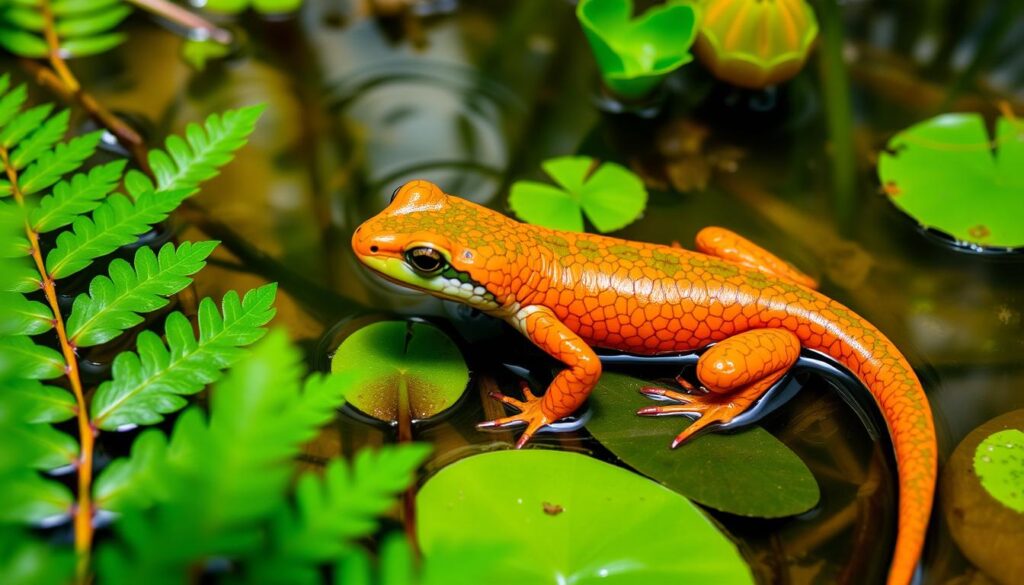
“Newts are small, colorful amphibians that belong to the salamander family.”
What Animals Start With N
From the iconic Narwhal to the lesser-known Nuthatch, the animal kingdom is home to a diverse array of fascinating creatures whose names start with the letter N. These animals showcase the incredible diversity of life on our planet, with each species possessing unique characteristics and adaptations. Whether it’s the Newt’s ability to regenerate lost body parts, the Nightingale’s melodious song, or the Nutria’s webbed feet, animals that start with N offer endless opportunities for exploration and discovery.
According to the provided statistics, there are 6 mammals starting with the letter N, such as the Naked Mole Rat, Nalolo, and Numbat. Additionally, 2 of the listed birds are nocturnal, the Nighthawks and Nightingales. The Narwhal, a mammal found in Arctic waters, is known for its unique tusk, present mostly in males.
The Nabarlek, a marsupial from Australia, is noted as an endangered species with a small declining population. The Natterjack Toad, an amphibian distinguished by a yellow line along its back, is prevalent in heathlands and sand dunes in Europe. The Nalolo fish, belonging to the Blenniidae family, is located in the Indian Ocean.
The animal kingdom’s diversity extends to a wide range of species starting with N, including the Ñandú (also known as Rhea), a flightless bird found in South America, and the Nautilus, a cephalopod mollusk present in the Indo-Pacific region.
| Animal | Description | Conservation Status |
|---|---|---|
| Narwhal | A unique mammal with a tusk, found in Arctic waters | Least Concern |
| Nabarlek | A marsupial from Australia, endangered with a small declining population | Endangered |
| Natterjack Toad | An amphibian distinguished by a yellow line along its back, prevalent in heathlands and sand dunes in Europe | Least Concern |
| Nalolo | A fish belonging to the Blenniidae family, located in the Indian Ocean | Least Concern |
The diversity of animals starting with N is truly remarkable, showcasing the incredible richness of the natural world. From the majestic Narwhal to the diminutive Nuthatch, these creatures offer endless fascination and wonder for those who take the time to explore them.
Nuthatch: The Upside-Down Acrobat
Perched atop a tree trunk, the nuthatch (Sitta species) showcases its remarkable agility as it scurries headfirst down the bark, in search of insects, seeds, and other tasty morsels. This small, stocky bird is a fascinating addition to the diverse world of creatures that start with the letter “N”.
The Nuthatch’s Unique Foraging Habits
Nuthatches are known for their distinctive “yank yank” call, which they use to communicate and defend their territory. Their specialized feet allow them to cling effortlessly to tree trunks, enabling these acrobatic birds to forage in a unique way. Unlike other birds that typically hop or fly from branch to branch, nuthatches can climb headfirst down the tree, searching every nook and cranny for their preferred prey.
This adaptable foraging technique sets the nuthatch apart from its avian counterparts. By accessing food sources that are often overlooked by other birds, the nuthatch maximizes its chances of survival in a variety of wooded habitats, from dense forests to urban parks.
| Nuthatch Facts | Nuthatch Behavior | Nuthatch Habitat |
|---|---|---|
| Small, stocky bird with a long, pointed bill | Climb headfirst down tree trunks | Wooded areas, including forests, parks, and urban settings |
| Distinctive “yank yank” call | Use specialized feet to cling to bark | Found throughout North America, Europe, and Asia |
| Omnivorous, feeding on insects, seeds, and nuts | Defend their territory with their calls | Prefer areas with a mix of deciduous and coniferous trees |
With their captivating behaviors and adaptable foraging techniques, nuthatches are a true marvel of the avian world. As you explore the natural wonders of the “N” animals, be sure to keep an eye out for these acrobatic upside-down climbers.
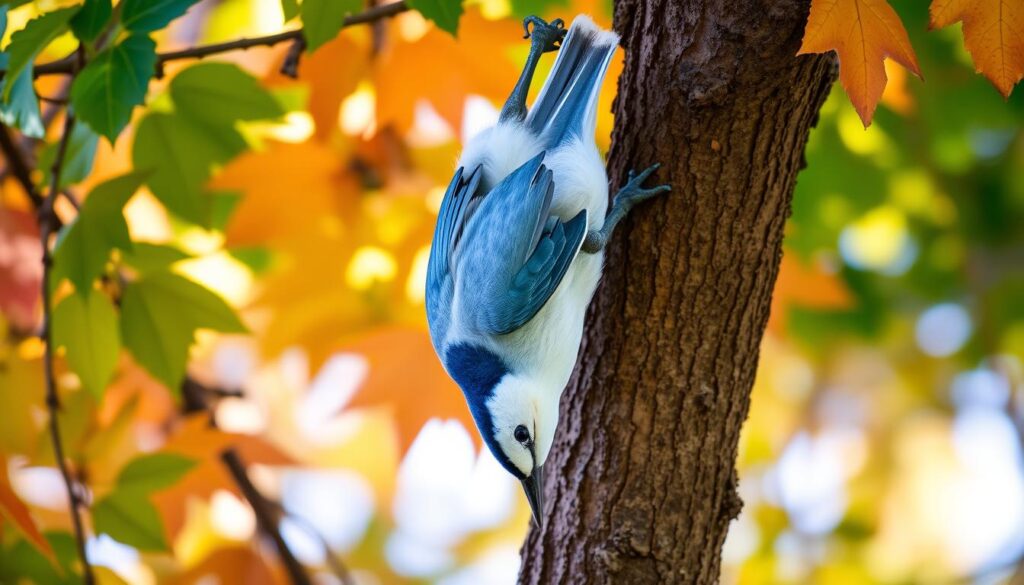
“Nuthatches are one of the most interesting and unique birds in the world, with their ability to climb headfirst down tree trunks and their distinctive call.”
Nene Goose: Hawaii’s State Bird
The nene goose, also known as the Hawaiian goose, is a rare and unique species that holds special significance for the Hawaiian islands. As the official state bird of Hawaii, the nene (Branta sandvicensis) is a captivating creature that has captivated both residents and visitors alike.
This distinctive goose is well-adapted to the volcanic landscapes of Hawaii, thriving in the island’s diverse habitats, including shrubland, grassland, coastal dunes, and lava plains up to an elevation of 2,400 meters. With a population of just 3,862 birds, the nene is considered the world’s rarest goose, a testament to the challenges it has faced over the years.
The nene is recognized for its gentle nature and unique appearance, with a long neck, black head, and distinctive yellow cheeks. These geese have a longer breeding season than any other goose, laying their eggs between November and January and incubating them for 29 to 32 days.
Conservation efforts have been a crucial focus in recent years, as the nene population was once reduced to just 30 birds by 1952 due to hunting and the introduction of predators. Through captive breeding programs and reintroduction initiatives, the nene population has slowly recovered, with successful breeding in the wild on the islands of Kauai and Maui.
| Nene Goose Facts | Details |
|---|---|
| Conservation Status | Near Threatened (IUCN 3.1) |
| Population | 3,862 birds |
| Initial Population Decline | Reduced to 30 birds by 1952 due to hunting and introduced predators |
| Breeding Season | August to April, longer than any other goose |
| Egg Laying | Most eggs laid between November and January |
| Incubation Period | 29 to 32 days |
| Breeding Habitats | Shrubland, grassland, coastal dunes, and lava plains up to 2,400 m in elevation |
| Diet | Herbivorous, feeding on leaves, seeds, fruit, and flowers of grasses and shrubs |
| Official State Bird Designation | Designated as the official state bird of Hawaii in 1957 |
| Range Restriction | Currently found only on Hawaii, Maui, Molokai, and Kauai |
As a symbol of Hawaii’s natural heritage, the nene continues to captivate and inspire both residents and visitors to the islands. Through ongoing conservation efforts and public awareness, this unique and endangered species has a chance to thrive for generations to come.
Nutria: The Burrowing Rodent
Nutrias, also known as coypus, are semi-aquatic rodents that belong to the order Rodentia and family Echimyidae. These large, furry creatures can weigh between 4 to 9 kg, with some individuals reaching up to 16 to 17 kg in size. Measuring around 40 to 60 cm in body length, nutrias are known for their webbed feet, which make them adept at navigating their watery habitats.
Originating from South America, nutrias have been introduced to various regions around the world, including North America, Europe, and Asia. In the United States, they were first brought in for the fur trade in 1889 and have since spread to at least 20 states, primarily the Gulf Coast region. Nutrias are known for their destructive burrowing and feeding habits, often making them an invasive species that can cause significant damage to levees, crops, and local ecosystems.
Despite their adaptability, nutrias typically have a lifespan of only three years in the wild, with 80% of them dying within the first year. However, they are highly prolific, with female nutrias capable of becoming pregnant within two days after giving birth and producing as many as 13 offspring per gestation period of 130 days. This reproductive capability, combined with their semi-aquatic lifestyle and voracious appetite for aquatic plants, has made nutrias a challenging species to manage in regions where they have been introduced.

